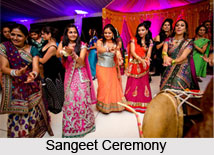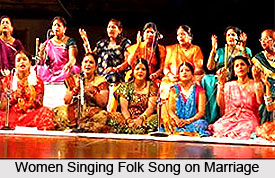 Folk songs on marriage are essentially lyrics sung by women. These songs cover a wide range of subject matter related to marriage. The various subjects that are connected with marriage or married life also come within the purview of these songs: a girl`s longing for love and marriage, initial inhibitions, usual apprehensions, and the actual ceremony. Once the wedding ceremony is over a new life begins. There are various songs expressing joy at this union, the sensation of two young souls living together, the warmth of heart and embrace. However, these are just the positive aspects of marriage. Apart from this, there are also songs which talk about the problems that beset marital life. Apart from marriage, they also deal with the economic problems which the young couple has to face in the rural areas. These have found an adequate expression in folksongs, as all the lyrics and sentiments of the peasant folk songs stem from the peasant`s immediate experience.
Folk songs on marriage are essentially lyrics sung by women. These songs cover a wide range of subject matter related to marriage. The various subjects that are connected with marriage or married life also come within the purview of these songs: a girl`s longing for love and marriage, initial inhibitions, usual apprehensions, and the actual ceremony. Once the wedding ceremony is over a new life begins. There are various songs expressing joy at this union, the sensation of two young souls living together, the warmth of heart and embrace. However, these are just the positive aspects of marriage. Apart from this, there are also songs which talk about the problems that beset marital life. Apart from marriage, they also deal with the economic problems which the young couple has to face in the rural areas. These have found an adequate expression in folksongs, as all the lyrics and sentiments of the peasant folk songs stem from the peasant`s immediate experience.
Themes of Folk Songs on Marriage
There are numerous songs celebrating the togetherness of youth that marriage entails. The rites and rituals of getting ready for marriage, the shyness of the girl, the aggression of the boy, good wishes for the married couple, blessings for a happy married life, preparations for being a wife- all these find ample expression in the various folk songs on marriage.
 Since these songs are mostly composed and sung by women, they reflect the women`s emotions and state of being in great depth. Some of them describe the difficulties of a woman in a strange house and her emotional reaction to this life. There are yet other songs which speak about the agonies of the system of compulsory acceptance of bridegrooms by girls seen in Indian society. Some husbands are domineering in attitude. Besides, there-is the problem of unsympathetic parents-in-law. The joint-family structure, a compulsion of agrarian economy, adds to the problem. There are taunting sisters-in-law also. All these factors contribute to making married life a problem of deep magnitude. To add to this, the problem of polygamous family remains. In agrarian economy and undivided patriarchal families, the daughter-in-law is a worker. She is an economic unit of production. She must have health, energy and vigour, and must be capable of hard work. The outward beauty of a girl was rarely a matter of consideration in the choice of a daughter-in-law. She needed to be healthy in order to discharge her second responsibility i.e., the production of healthy children to replace the older folks as workers in the field. It was found that one woman was not enough to discharge all these responsibilities. This is the starting point of polygamous families in peasant society, a compulsion of agricultural economy. This aspect of life is celebrated in folksongs.
Since these songs are mostly composed and sung by women, they reflect the women`s emotions and state of being in great depth. Some of them describe the difficulties of a woman in a strange house and her emotional reaction to this life. There are yet other songs which speak about the agonies of the system of compulsory acceptance of bridegrooms by girls seen in Indian society. Some husbands are domineering in attitude. Besides, there-is the problem of unsympathetic parents-in-law. The joint-family structure, a compulsion of agrarian economy, adds to the problem. There are taunting sisters-in-law also. All these factors contribute to making married life a problem of deep magnitude. To add to this, the problem of polygamous family remains. In agrarian economy and undivided patriarchal families, the daughter-in-law is a worker. She is an economic unit of production. She must have health, energy and vigour, and must be capable of hard work. The outward beauty of a girl was rarely a matter of consideration in the choice of a daughter-in-law. She needed to be healthy in order to discharge her second responsibility i.e., the production of healthy children to replace the older folks as workers in the field. It was found that one woman was not enough to discharge all these responsibilities. This is the starting point of polygamous families in peasant society, a compulsion of agricultural economy. This aspect of life is celebrated in folksongs.
Apart from the economic problems, the folk songs on marriage also give expression to matter of the heart. They are songs of longing for some one near and dear, possibly left behind in the native village. These are songs of personal emotions; they are mournful in tone and rhythm. Some of these songs express a certain level of revolt and anger. Thus, a whole gamut of experiences finds a consolidated expression in the songs of married life.




